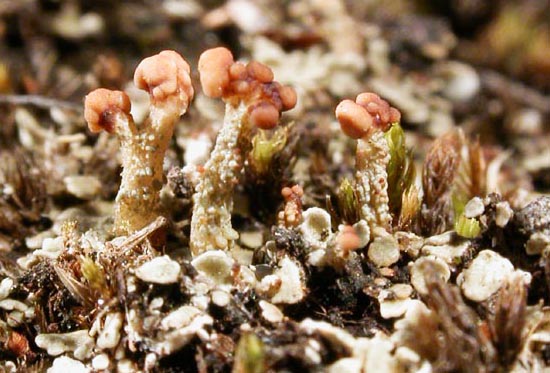(Adapted from Chambers, 2003)

Photo: Alan Orange

C.peziziformis is a terricolous lichen of open, shallow peaty or sandy ground in oceanic lowland and submontane heaths (Orange 1996; Purvis et al. 1992). The vast majority of records are from heathland within a short distance of the coast and the species displays a pronounced 'L-shaped' southerly and westerly distribution in Britain, mirrored by certain Atlantic pteridophytes, such as Dryopteris aemula and Hymenophyllum tunbrigense. The species is intolerant of phanerogamic competitors and appears to have a requirement for bare ground exposed during heath fires. It is possible that the trophic conditions provided by plant ash nutrients released in the aftermath of burns play some role in its ecology and life history and perhaps trigger its appearance from a spore or conidial bank in the soil, though no experimental work has been carried out to investigate this. Nothing is known of its long-range dispersal capabilities. Whether or not disturbance by fire is a prerequisite is also unknown, but recent finds here and in Europe have all been associated with burnt ground. Where C.peziziformis is found the ground typically has a thin peat covering with a significant sandy or mineral fraction. Some sites are associated with igneous geology and nutrient balance appears to be a key factor in the ecology of the species. In this respect it appears to have ecological similarities with Placynthiella oligotropha but occupies more or less constantly humid, cooler and much less xeric niches.
N. & S. America, Asia, Macaronesia, W. Europe and Western British Isles. Very rare and probably ephemeral at most sites. In Wales, recorded from 5 locations post-1980.
Records from Wales (some older and poorly-localised records have been ommitted):
| Location | Grid Reference | Last Rec'd | Recorder | SSSI |
| Anglesey: South Stack | SH208819 | 2007 | S.P. Chambers | Yes |
| Caernarfon:Mynydd Garngwch | SH374425 | 2002 | S.P. Chambers | No |
| Pembs: Dowrog Common | SM770269 | 1989 | A.O. Orange | Yes |
Notes adapted from Chambers (2003)
Mynydd Carngwch, Caerns.: C.peziziformis was found here over a roughly rectangular area ca. 200 x 40m in previously burnt H8b Calluna vulgaris − Ulex gallii heath (Danthonia decumbens sub-community) on the gently sloping (10−15 degrees inclination) lower flank of a hill,SW−aspect (200 − 220 degrees). It was seen ca. 16 times in ca. 15 minutes, growing in damp pockets of peaty−mineral soil, exposed by burning, between recovering dwarf shrubs and vascular plants. Patch size ranged from 1−4cm across. About half (8) of the patches seen were fertile. Close associates included Ulex gallii (regenerating young shoots), Erica cinerea (small seedlings), Danthonia decumbens, Polygala serpyllifolia, Deschampsia flexuosa and Carex pilulifera. The population appeared strong and healthy but the vegetation was moving towards 'closure' and Steve Chambers concluded that C.peziziformis would likely become excluded within 3−5 years without another disturbance episode.
Sterile thalli could be overlooked, though the specialised habitat and UKBAP-raised profile means it has attracted increased awareness and it is high on any lichenologist's 'wish list' when working coastal heath. Consequently it is unlikely to be seriously under-recorded.
Chambers, S.P. (2003). Site Dossiers for the UK BAP lichens Biatoridium monasteriense, Cladonia peziziformis, Graphina pauciloculata and Schismatomma graphidioides. CCW Contract Science Report No. 586
- Log in to post comments

